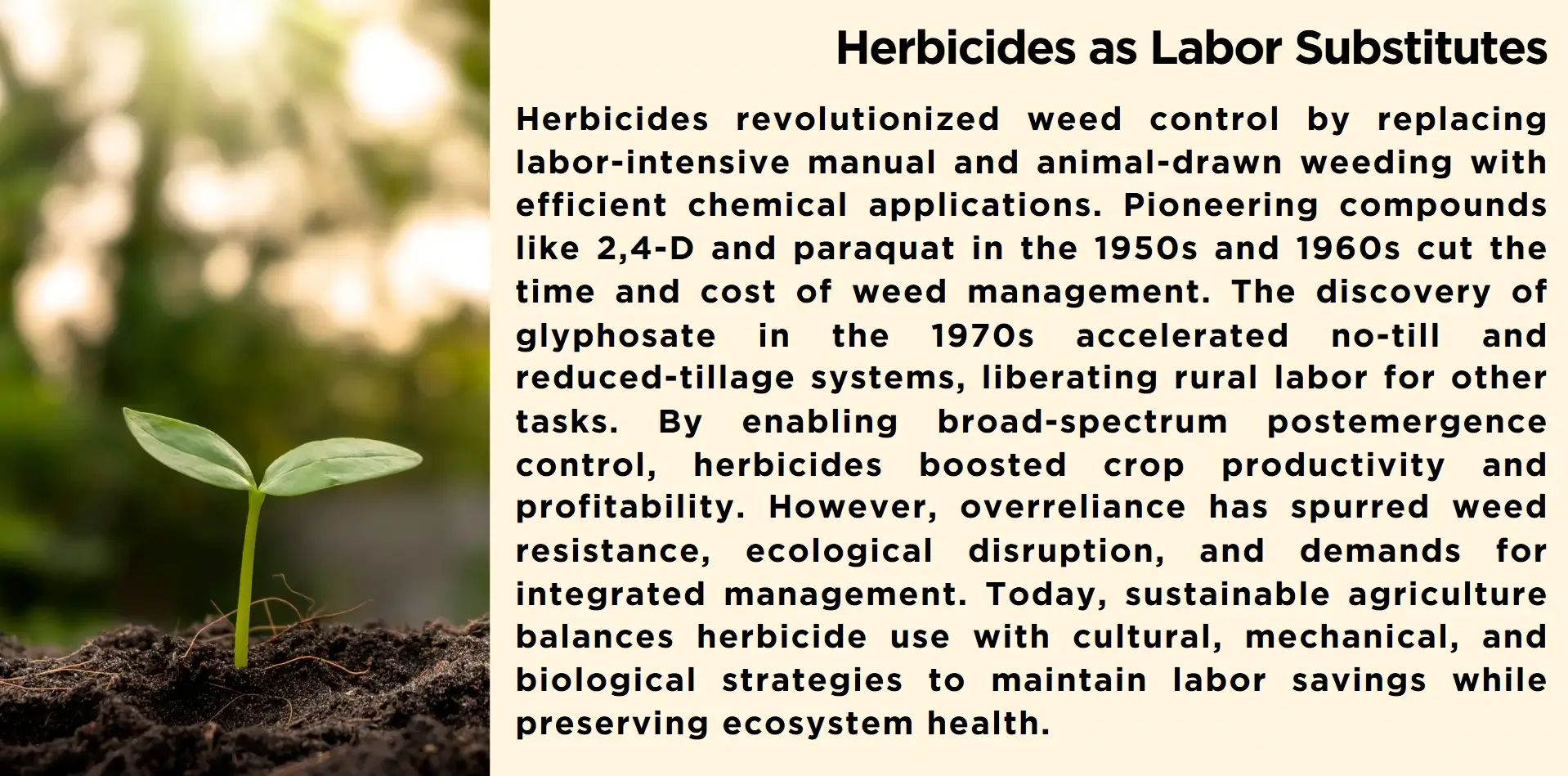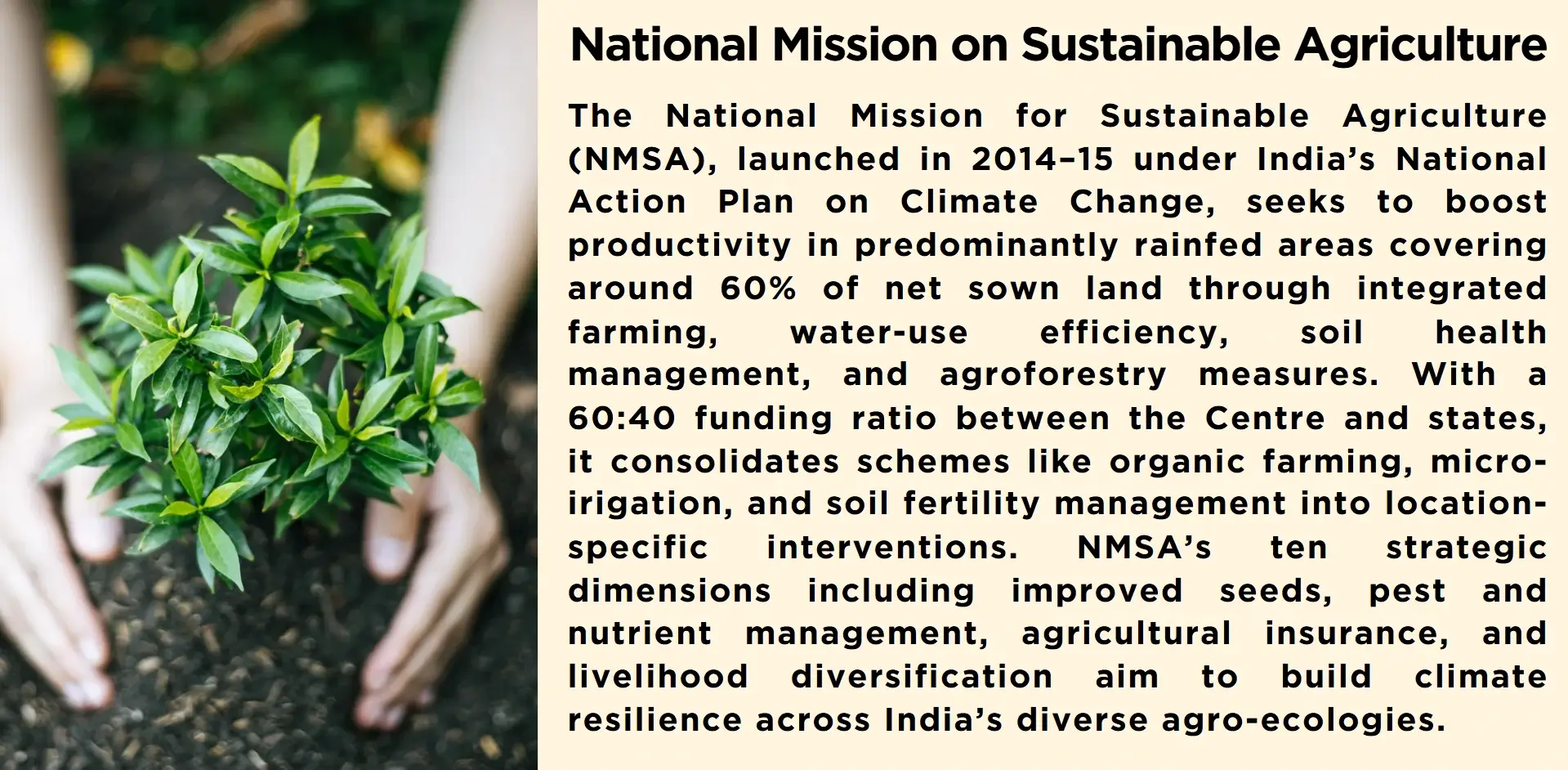The Indian pesticide market is also transitioning to herbicides due to the increasing problem of labor deficiencies and mechanized incursions into farming practices and a new discourse of crop management necessitating proficient weed control.

The Indian pesticide market that had hitherto been dominated by the use of insecticides and fungicides associated with the Green Revolution is going through a sea change. The focus is now being directed to the herbicides and these are the chemicals that attack the unwanted plants and the farmers are now turning to the herbicides as a more functional way of combating weeds. The upward spiral in crop prices is venerated not by crop demands, but by a spiralling problem with labor shortages in farms. The agricultural labour has become economically and logistically unsustainable with rural-to-urban migration, an increase in wage pressure, and a loss of interest in manual farm labour. This is causing a faster rate of use of herbicides, particularly in rice, maize, and soybean crops, where mechanization and weed control at the right time are critical to crop production.The use and safety of herbicides in the environment bring up important questions about sustainability, the environment, and legal frameworks. This event also marks a more general change in the model of the agricultural economy of India, one that is influenced by demography, technology, and policy. This article examines the emerging nature and trends of pesticide use in India with a particular focus on the increasing role being played by herbicides, no longer merely an alternative to labor but an alternative foreseeable means of coping with other labor issues in rural agriculture and cropping intensification.
Historical Overview
Pesticide history in India reflects its agricultural transitions, starting with the colonial influences to the agricultural intensification after independence and current environmental issues.
Colonial Underpinnings
Under the British colonial regime, India had to use traditional methods of pest control that vividly included measures like neem extracts, ash and manual input. Synthetic pesticides were rarely used until the mid-1900s, and tea and cotton plantations were imported sparingly. The resultant low usage was characterized by poor reception and limited access to chemical technologies
The Green Revolution
This was the high point in the 60s when the Revolution embarked. India adopted synthetic pesticides, mainly organochlorines (such as DDT and BHC), in an effort to overcome pests that previously limits the yield of the better wheat and rice varieties. The adoption greatly increased with the help of government funding and international cooperation’s, thus making it a national priority. But blind use was soon to raise some red flags of opposition and side effects on the ecology.
The Regulatory measures
In the late eighties, there was an emergence of health and environmental issues using pesticides. India provided the Insecticides Act of 1968; it was then supported with stricter restrictions and prohibitions of chemicals that were dangerous. The approach of activism and research brought attention to the problem of poisoning and biodiversity loss caused by pesticides, water and soil pollution, which resulted in some changed policies in using safer alternatives.
Towards Integrated Pest Management (IPM)
Since the 1990s, India is slowly shifting to Integrated Pest Management (IPM) in favour of biological pests, crop rotation and selective use of pesticides. Although adoption is not yet balanced, the interest towards striking the right balance between productivity and sustainability continues to increase as expressed by IPM. New developments are in the use of bio-pesticides, precision spraying and a policy of stricter residue limits in keeping with global trade requirements.
Structural Labor Shortage
Less availability of labor to Indian agriculture is not a remote phenomenon: this concern is part of underlying demographic, economic, and sociocultural changes in the decision-making processes at the farm level, across regions.
Rural out-migration and Demographic change
The rural belt of India has recorded a steady exodus of the working age oriented towards the urban areas due to the dream of education, industrial jobs, and improved standards of life. Due to the movement of the younger generation to cities, or the refusal of rural young people to work on the farm, the sources of labor are becoming scarce and rural people, who are mostly older, will have to operate more mechanized industries. A consequence of it is the feminization of agriculture, yet it is commonly through inadequate training and a lack of resources.
Economic Deterrents and Price Strains
The increased rural wages, especially post-2000s (at least partly, as the result of implementation of employment programs and schemes, such as MGNREGA, and the inflationary trends) have rendered manual weeding and harvesting more expensive. Most farmers who are small and marginal cannot afford to continue working. Labor shortages in the high season of sowing and collecting, which aggravate the risk of a drop in productivity, lead to the replacement of mechanized sowing or chemical solutions, such as herbicides.
Deterioration of Customary Systems of Labor
Traditionally, the work in the agricultural sector was negotiated by the reciprocators or caste-oriented mechanisms, particularly in the semi-feudal edge economies. Such arrangements have been destroyed by the changing social norms and legal reforms. Modernized agriculture presently needs contracted labor, which tends to be on call and locally scattered, particularly in rainfed areas and hilly regions where there is no mechanization thus far.

Herbicides as Substitutes to Labor
The structural labour gap has directly caused the input in the adoption of herbicides. Chemical weed control that is quick-acting provides growers with a dependable, extensible, and inexpensive means of sustaining the well-being of crops devoid of having to depend on limited manual labor. This is not only a choice,it is a need that has been created by demographic and economic readjustment.
The Reason Why Herbicides are Booming
The boom in herbicides in India symbolizes greater changes in the mode of farming, workforce patterns, and crop control methods. Compared to the simple term of being convenient, it reflects a tactical response to changes at the farm level.
Precision Agriculture Shift
Contemporary agriculture in India is also taking the form of input productivity and intervention at the appropriate times. Herbicides fit this model well because they assure farmers consistent weed management and compatibility with direct-seeded crops or zero-till cropping. In rice and maize crops, where weed control is crucial at the correct time, the use of herbicides would help in precision application without disturbing the soil structure, thereby enhancing yield and soil health.
Labor Substitution and Economic Efficiency
Manual weeding requires a lot of labor force and it is time-constrained as well as expensive, particularly at the time of monsoon peaks of crop cultivation. Herbicides provide a rampable option that diminishes reliance on labor, which is in short supply and helps to avoid peak season wage increased costs. Herbicides are economically important to the small and marginal farmers in the sense that theyhelp them control the weeds even in distant regions with weak or fluctuating labor markets, where herbicides are not a luxury but a necessity.
Chemical Formulation Innovation
The agrochemical sector has countered this with the latest formulations of herbicides specific to crops, causing fewer environmental hazards with improved weed-specific concentration scope. It is on this basis that pre-emergent and post-emergent products are currently available to suit various agroclimatic regions. Greater adoption has been seen especially in states such as Punjab, Andhra Pradesh and Chhattisgarh due to better packaging, farmer training and marketing campaigns.
Market and Policy Levers
Gentler import standards, a surge of investment in the country by the private sector, and access to subsidy structures in some parts are also facets promoting the increasing demand of herbicides in India. Improved mechanization promoted by the government, coupled with precision management of nutrients and pests,has an indirect effect on increasing herbicide intakes as a constituent part of integrated farm solutions.
Economic and Policy Aspects
Agribusiness and Economic Incentives
The use of herbicides is progressively becoming an attractive source of economic solutions in the evolving agricultural economy of India. Chemical weed control will not only help farmers save laborcosts, but also will increase the productivity of the crop, as input costs increase and the profit margins narrow. Agri-entrepreneurs as well as smallholders prefer herbicides because of their predictability of results and reduced operation risk. This pressure has led to an increase in the agrochemical industry, spurring both the entry of private investments and increasing domestic manufacturing capabilities.

Regulatory Trajectories and Policy Frameworks
Despite the fact that herbicides are not as regulated as insecticides, the policy environment is changing. The Ministry of Agriculture has made available schemes under the National Mission on Sustainable Agriculture with respect to weed growth and some states offer subsidies on a restricted basis towards the purchase of herbicides. There are regulatory processes that are moving towards stricter in formulation and the surveillance of residues with newer draft bills to replace the Insecticides Act. Nevertheless, there exist policy gaps related to licensing, farmer education and ecological risk assessments, which require harmonized federal and state-level policies.
Environmental and Health Issues
Increasing herbicide application in India has raised serious questions regarding environmental sustainability and the health of human beings.
- Newer formulations are designed to be less toxic, but broad chemical use tends to destroy microbial diversity in soils, groundwater pollution, and jeopardize non-target flora and fauna. In biodiversity-poor areas and rainfed areas, this may result in the long-run loss of land and water quality due to uncontrolled spraying.
- Human health-wise, there is evidence of skin irritation, respiratory illnesses, and in certain situations, endocrine disruption when impregnated with herbicides systemically (especially when the farms are manned by farm workers).
- These risks are aggravated by improper handling, lack of protective gear and equipment, and poor training, especially in low-literacy rural environments. The problem of residue accumulation within the food chain is also a concern about the safety of consumers and international trade regulations.
- India's regulatory outlook is very disjointed, and little is being done to ensure safety measures, residue checks. Despite the promotion of bio-pesticides and integrated weed management as part of the missions in sustainable agriculture, their uptakeareslow because of market aspects and a lack of awareness.
- A more proactive solution will demand extensive farmer training, risk-rate evaluations specific to a region, and investment into more productive but less harmful forms of making money, which have minimal impact on ecology.
Innovation and Transition
The current state of India, its herbicides, and its landscape are at the brink of a paradigm shift, one that is fuelled by technological innovation, ecological awareness, and a much-needed institutional change.
- The future of weed management will probably involve chemical efficacy and sustainable solutions to be utilized, to form hybrids that would be scalable and sustainable.
- The innovations that are emerging are drone-based precision spraying, AI-enabled weed recognition, and the creation of biodegradable formulations of herbicides according to local cropping systems.
- Nanotechnology delivery systems are already on vendors of managed care organizations and start-ups through public-private partnerships that are in the process of integrating apps to facilitate dose optimization.
- In the meantime, it is expected to be achieved by a change in policy with the revised regulations of agrochemicals, more stringent residue limits, and incentives to non-toxic alternatives within missions like PM-PRANAM and National Bio-Energy Programme.
- Such frameworks will necessitate effective extension services that will be used to train farmers in optimal practices and safe handling techniques, as well as localised innovation.
- The future herbicide trajectory in India is not a straight line; it will take the form of the democratization of innovation across a wide variety of agroecologies as well as socioeconomic classes.
- To provide a robust and fair future of farming, it is essential to look at the balance between high-tech solutions and grassroots availability. Instead of replacing conventional ways of dealing with weeds altogether, the emerging period could combine traditional techniques, biotechnology, and digital systems in a new fabric of sustainable management of weeds.
Conclusion
In India, the increased use of herbicides is not merely a change in equipment used in farming, but it reflects more comprehensive changes in the sphere of labor, technology, policymaking,and environmental cognizance. The continued shortage of structural labor and the increasing economic pressure on farmers are providing practical relief to farmers via chemical weed control. The boom is a sign that a farm economy is in transition, trying to compete with others in terms of productivity and managing the environmental risks they face, as well as government changes.The future of India will hinge on the extent to which this nation can incorporate innovation with sustainability, making best use of new technologies, investing more in the education of farmers and coming up with more inclusive policies that place an emphasis on economic profitability and environmental health as well. Instead of using herbicides as a magical bullet, they are to be placed within a diversified weed management plan that is based on local conditions. The path to the future is a narrow one, and actions taken now will determine how the landscape of Indian agriculture is going to look in the future.